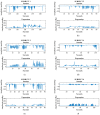A Low-Cost Device for Measuring Non-Nutritive Sucking in Newborns
- PMID: 40871943
- PMCID: PMC12389948
- DOI: 10.3390/s25165080
A Low-Cost Device for Measuring Non-Nutritive Sucking in Newborns
Abstract
Non-nutritive sucking (NNS) is an instinctive behavior in newborns, consisting of two stages: sucking and expression. It plays a critical role in preparing the infant for oral feeding. In neonatal and pediatric units, NNS assessment is routinely performed to determine feeding readiness. However, these evaluations are often subjective and rely heavily on the clinician's experience. While other medical devices that support the development of NNS skills exist, they are not specifically designed for the comprehensive assessment of NNS, and their high cost limits accessibility for many hospitals and tertiary care units globally. This paper presents the development and pilot testing of a low-cost, portable device and accompanying software for assessing NNS in newborns hospitalized in neonatal care units. Methods: The device uses force-sensitive resistors to capture expression pressure and a differential pressure sensor to measure NNS. Data were acquired through the analog-digital converter of a microcontroller and transmitted via Bluetooth for real-time graphical analysis. Pilot testing was conducted with six hospitalized preterm newborns, measuring intensity, number of bursts, and sucks per burst. Results demonstrated that the system reliably captures both stages of NNS. Significance: This device provides an affordable, portable solution to support clinical decision-making in clinical units, facilitating accurate, objective monitoring of feeding readiness and developmental progression.
Keywords: force sensing resistors; non-nutritive sucking; piezoresistive pressure sensors.
Conflict of interest statement
The authors declare no conflicts of interest.
Figures













Similar articles
-
Non-nutritive sucking for promoting physiologic stability and nutrition in preterm infants.Cochrane Database Syst Rev. 2005 Oct 19;(4):CD001071. doi: 10.1002/14651858.CD001071.pub2. Cochrane Database Syst Rev. 2005. Update in: Cochrane Database Syst Rev. 2016 Oct 04;10:CD001071. doi: 10.1002/14651858.CD001071.pub3. PMID: 16235279 Updated.
-
Non-nutritive sucking for promoting physiologic stability and nutrition in preterm infants.Cochrane Database Syst Rev. 2001;(3):CD001071. doi: 10.1002/14651858.CD001071. Cochrane Database Syst Rev. 2001. Update in: Cochrane Database Syst Rev. 2005 Oct 19;(4):CD001071. doi: 10.1002/14651858.CD001071.pub2. PMID: 11686975 Updated.
-
Non-nutritive sucking for promoting physiologic stability and nutrition in preterm infants.Cochrane Database Syst Rev. 2000;(2):CD001071. doi: 10.1002/14651858.CD001071. Cochrane Database Syst Rev. 2000. Update in: Cochrane Database Syst Rev. 2001;(3):CD001071. doi: 10.1002/14651858.CD001071. PMID: 10796407 Updated.
-
Effectiveness of Non-Nutritive Sucking on Sucking Performance in Preterm Infants: A Systematic Review.Phys Occup Ther Pediatr. 2025;45(4):517-540. doi: 10.1080/01942638.2025.2451405. Epub 2025 Jan 20. Phys Occup Ther Pediatr. 2025. PMID: 39834048
-
Prescription of Controlled Substances: Benefits and Risks.2025 Jul 6. In: StatPearls [Internet]. Treasure Island (FL): StatPearls Publishing; 2025 Jan–. 2025 Jul 6. In: StatPearls [Internet]. Treasure Island (FL): StatPearls Publishing; 2025 Jan–. PMID: 30726003 Free Books & Documents.
References
-
- Xin M., Yu T., Jiang Y., Tao R., Li J., Ran F., Zhu T., Huang J., Zhang J., Zhang J.H., et al. Multi-vital on-skin optoelectronic biosensor for assessing regional tissue hemodynamics. SmartMat. 2023;4:e1157. doi: 10.1002/smm2.1157. - DOI
-
- Chen Y., Lei H., Gao Z., Liu J., Zhang F., Wen Z., Sun X. Energy autonomous electronic skin with direct temperature-pressure perception. Nano Energy. 2022;98:107273. doi: 10.1016/j.nanoen.2022.107273. - DOI
-
- Rendón-Macías M.E., Serrano Meneses G.J. Physiology of nutritive sucking in newborns and infants. Bol. Méd. Hosp. Infant. Méx. 2011;68:319–327.
MeSH terms
Grants and funding
LinkOut - more resources
Full Text Sources

